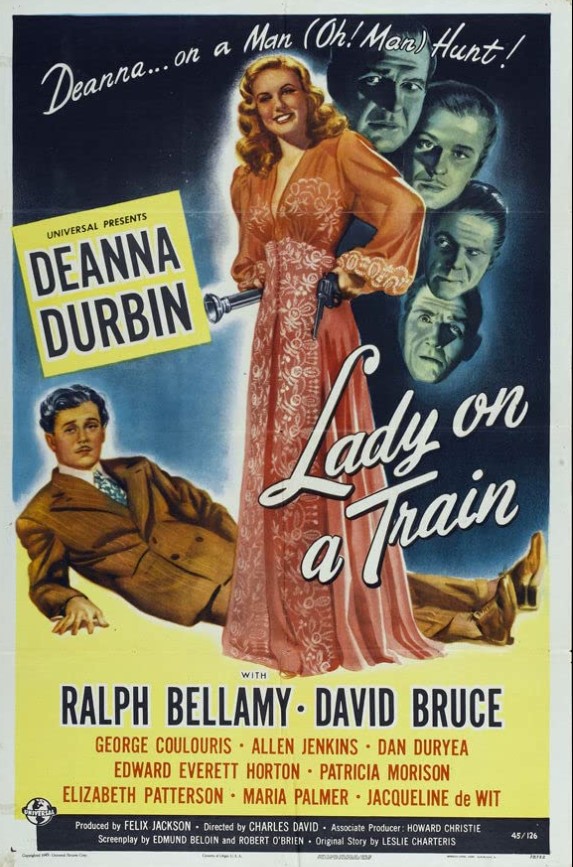
We started our Christmas in New York movies with this mixed genre film that blends mystery, comedy, romance, and music. It begins with a train arriving in Manhattan, which is why we put this film first on our list — our trips to New York always begin on a train. The film stars 24-year-old Deanna Durbin, best known today as a rival to Judy Garland. The two actually appeared together in an MGM short, Every Sunday (1936), with Durbin showcasing her operatic soprano voice and Garland singing in a mature swing style. Durbin later moved to Universal Studios and was actually a bigger star than Garland during the late ‘30s and early ‘40s.
Durbin sings three times in Lady on a Train: “Silent Night” on the telephone to her father and then two numbers in a night club — “Give Me a Little Kiss” and a sultry version of Cole Porter’s “Night and Day.”
PLOT SUMMARY
After witnessing a murder from the window of her train, a young heiress enlists a mystery writer in her sleuthing, finding both the killer and romance. The plot is both convoluted and cliched, but there are several amusing scenes. The script was based on a story by Leslie Charteris, the author of The Saint mystery novels, which were turned into a popular series of films in the late 1930s and a TV series in the 1960s.
CHRISTMAS CONNECTION
Frankly, the Christmas connections in the plot are only incidental not integral. Other than the allegation that the murder victim died from a fall from a ladder while decorating his tree, there are few references to the holidays, save Durbin’s singing “Silent Night.”
NEW YORK SETTINGS
The opening shots show the train heading south in New York City toward Grand Central Terminal, so Durbin must be arriving on the New York Central’s 20th Century Limited from Chicago. There is a brief shot inside Grand Central showing the familiar ramps to the trains but not the grand interior, so it was likely filmed in Universal Studios in Hollywood.
CHARACTER ACTORS
Lots of familiar faces flesh out the film: Ralph Bellamy, Edward Everett Horton, and Allen Jenkins.
ASTAIRE CONNECTION
One of the screenwriters, Robert O’Brien, also wrote the screenplay for The Belle of New York (1952). Edward Everett Horton appeared in three different Astaire-Rogers musicals: The Gay Divorcee (1934), Top Hat (1935), and Shall We Dance (1937). (Horton sports a black eye in both Top Hat and Lady on a Train.) Cole Porter wrote “Night and Day” for Astaire’s last Broadway musical, The Gay Divorce (1932). It was the only song retained for the film version.
WHY WE LOVE THIS MOVIE
We actually don’t love this movie, but the supposed scenes in New York and Durbin’s lovely voice, especially her rendition of “Night and Day,” make the film worth watching once every three years or so. It’s definitely not an A-list.
WHAT WE NOTICED THIS TIME
We noticed Leslie Charteris’s name in the story credit, and that made us search out some of his Saint novellas. We may start watching some of the films in that series from the 1930s and ’40s in the new year.